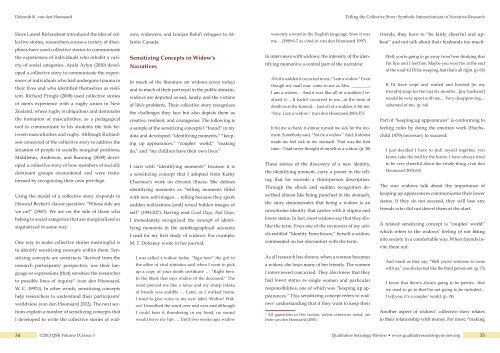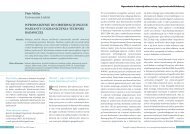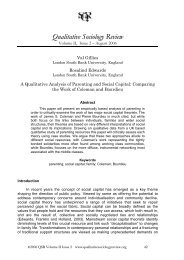Deborah K. van den Hoonaard St. Thomas University, Canada ...
Deborah K. van den Hoonaard St. Thomas University, Canada ...
Deborah K. van den Hoonaard St. Thomas University, Canada ...
Create successful ePaper yourself
Turn your PDF publications into a flip-book with our unique Google optimized e-Paper software.
<strong>Deborah</strong> K. <strong>van</strong> <strong>den</strong> <strong>Hoonaard</strong><br />
Telling the Collective <strong>St</strong>ory: Symbolic Interactionism in Narrative Research<br />
Since Laurel Richardson introduced the idea of collective<br />
stories, researchers across a variety of disci-<br />
ows, widowers, and Iranian Bahá’í refugees to Atlantic<br />
<strong>Canada</strong>.<br />
was only a word in the English language. Now it was<br />
me… (1989:6-7 as cited in <strong>van</strong> <strong>den</strong> <strong>Hoonaard</strong> 1997)<br />
friends, they have to “be fairly cheerful and upbeat”<br />
and not talk about their husbands too much:<br />
plines have used collective stories to communicate<br />
the experiences of individuals who inhabit a variety<br />
of social categories. Ayala Aylyn (2010) developed<br />
a collective story to communicate the experiences<br />
of individuals who had undergone trauma in<br />
their lives and who i<strong>den</strong>tified themselves as resilient.<br />
Richard Pringle (2008) used collective stories<br />
of men’s experience with a rugby union in New<br />
Zealand, where rugby is ubiquitous and dominates<br />
the formation of masculinities, as a pedagogical<br />
tool to communicate to his stu<strong>den</strong>ts the link between<br />
masculinities and rugby. Although Richardson<br />
conceived of the collective story to address the<br />
situation of people in socially marginal positions,<br />
Middleton, Anderson, and Banning (2009) developed<br />
a collective story of how members of socially<br />
dominant groups encountered and were transformed<br />
by recognizing their own privilege.<br />
Using the model of a collective story responds to<br />
Howard Becker’s classic question: “Whose side are<br />
we on?” (1967). We are on the side of those who<br />
belong to social categories that are marginalized or<br />
stigmatized in some way.<br />
One way to make collective stories meaningful is<br />
to i<strong>den</strong>tify sensitizing concepts within them. Sensitizing<br />
concepts are constructs “derived from the<br />
research participants’ perspective, use their language<br />
or expressions [that] sensitize the researcher<br />
to possible lines of inquiry” (<strong>van</strong> <strong>den</strong> <strong>Hoonaard</strong>,<br />
W. C. 1997:1). In other words, sensitizing concepts<br />
help researchers to understand their participants’<br />
worldview (<strong>van</strong> <strong>den</strong> <strong>Hoonaard</strong> 2012). The next sections<br />
explain a number of sensitizing concepts that<br />
I developed to write the collective stories of wid-<br />
Sensitizing Concepts in Widow’s<br />
Narratives<br />
In much of the literature on widows (even today)<br />
and in much of their portrayal in the public domain,<br />
widows are depicted as sad, lonely, and the victims<br />
of life’s problems. Their collective story recognizes<br />
the challenges they face but also depicts them as<br />
creative, resilient, and courageous. The following is<br />
a sample of the sensitizing concepts I “found” in my<br />
data and developed: “i<strong>den</strong>tifying moments,” “keeping<br />
up appearances,” “couples’ world,” “making<br />
do,” and “my children have their own lives.”<br />
I start with “i<strong>den</strong>tifying moments” because it is<br />
a sensitizing concept that I adopted from Kathy<br />
Charmaz’s work on chronic illness. She defines<br />
i<strong>den</strong>tifying moments as “telling moments filled<br />
with new self-images … telling because they spark<br />
sud<strong>den</strong> realizations [and] reveal hid<strong>den</strong> images of<br />
self” (1991:207). Having read Good Days, Bad Days,<br />
I immediately recognized the concept of i<strong>den</strong>tifying<br />
moments in the autobiographical accounts<br />
I read for my first study of widows. For example,<br />
M. T. Dohaney wrote in her journal:<br />
I was called a widow today. “Sign here” the girl in<br />
the office of vital statistics said when I went to pick<br />
up a copy of your death certificate … “Right here.<br />
In the block that says widow of the deceased.” The<br />
word pierced me like a lance and my sharp intake<br />
of breath was audible … Later, as I walked home,<br />
I tried to give voice to my new label. Widow! Widow!<br />
I mouthed the word over and over and although<br />
I could hear it thundering in my head, no sound<br />
would leave my lips … Until two weeks ago, widow<br />
In interviews with widows, the intensity of the i<strong>den</strong>tifying<br />
moment is a central part of the narrative:<br />
All of a sud<strong>den</strong> it occurred to me, “I am a widow.” Even<br />
though my mail may come to me as Mrs. ________,<br />
I am a widow… And it was like all of a sud<strong>den</strong> I realized<br />
it… It hadn’t occurred to me…at the time of<br />
death or at the funeral… Just all of a sud<strong>den</strong>, it hit me,<br />
“Hey, I am a widow.” (<strong>van</strong> <strong>den</strong> <strong>Hoonaard</strong> 2001:37) 1<br />
It hit me so hard, it almost turned me sick for the moment.<br />
Somebody said, “You’re a widow.” And, it almost<br />
made me feel sick to my stomach. That was the first<br />
time – I had never thought of myself as a widow. (p. 38)<br />
These stories of the discovery of a new i<strong>den</strong>tity,<br />
the i<strong>den</strong>tifying moment, carry a power in the telling<br />
that far exceeds a third-person description.<br />
Through the shock and sud<strong>den</strong> recognition described<br />
almost like being punched in the stomach,<br />
the story demonstrates that being a widow is an<br />
unwelcome i<strong>den</strong>tity that carries with it stigma and<br />
lower status. In fact, most widows say that they dislike<br />
the term. Even one of the reviewers of my article<br />
entitled “I<strong>den</strong>tity Foreclosure,” herself a widow,<br />
commented on her discomfort with the term.<br />
As all research has shown, when a woman becomes<br />
a widow, she loses many of her friends. The women<br />
I interviewed concurred. They also knew that they<br />
had lower status as single women and particular<br />
responsibilities, one of which was “keeping up appearances.”<br />
This sensitizing concept refers to widows’<br />
understanding that if they want to keep their<br />
1<br />
All quotations in this section, unless otherwise noted, are<br />
from <strong>van</strong> <strong>den</strong> <strong>Hoonaard</strong> (2001).<br />
Well, you’re going to go away from here thinking that<br />
I’m fine and I feel fine. Maybe you won’t be at the end<br />
of the road ‘til I’ll be weeping, but that’s all right. (p. 65)<br />
If I’d have wept and wailed and howled [in my<br />
friend’s] soup for the last six months…[my husband]<br />
would be very upset with me… Very disapproving…<br />
ashamed of me. (p. 64)<br />
Part of “keeping up appearances” is conforming to<br />
feeling rules by doing the emotion work (Hochschild<br />
1979) necessary to succeed:<br />
I just decided I have to pull myself together, you<br />
know, take the bull by the horns. I have always tried<br />
to be very cheerful about the whole thing. (<strong>van</strong> <strong>den</strong><br />
<strong>Hoonaard</strong> 2001:65)<br />
The way widows talk about the importance of<br />
keeping up appearances communicates their lower<br />
status. If they do not succeed, they will lose any<br />
friends who did not desert them at the start.<br />
A related sensitizing concept is “couples’ world”<br />
which refers to the widows’ feeling of not fitting<br />
into society in a comfortable way. When friends invite<br />
them out:<br />
And much as they say, “Well you’re welcome to come<br />
with us,” you always feel like the third person out. (p. 73)<br />
I know that there’s always going to be parties…that<br />
we used to go to that I’m not going to be included…<br />
I tell you, it’s a couples’ world. (p. 74)<br />
Another aspect of widows’ collective story relates<br />
to their relationship with money. For most, “making<br />
34<br />
©2013 QSR Volume IX Issue 3<br />
Qualitative Sociology Review • www.qualitativesociologyreview.org 35

















